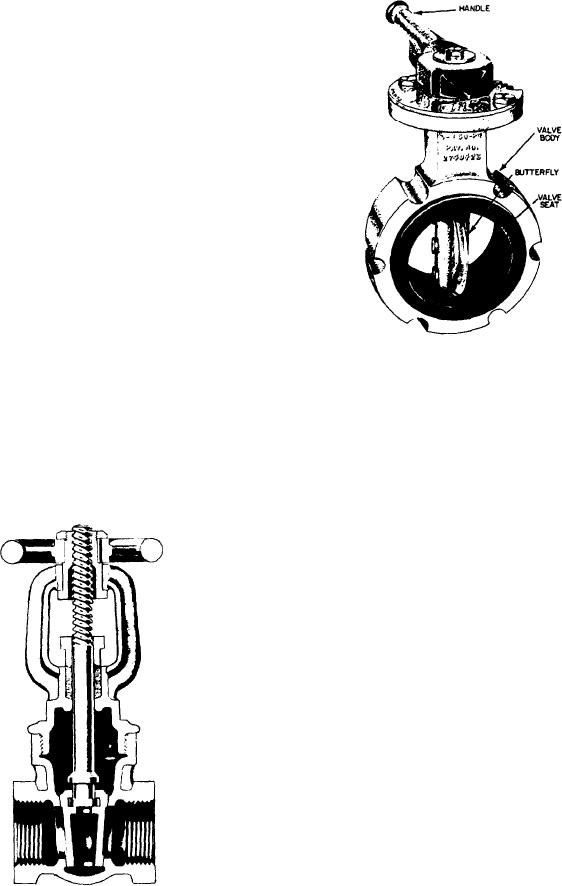
The rising-stem gate valve, shown in figure
6-3, has the stem attached to the gate; the gate
and stem rise and lower together as the valve is
operated.
Gate valves used in steam systems have flexible
gates. The reason for using a flexible gate is to
prevent binding of the gate within the valve when
the valve is in the closed position. When steam
lines are heated, they will expand, causing some
distortion of valve bodies. If a solid gate fits
snugly between the seat of a valve in a cold
steam system, when the system is heated and
pipes elongate, the seats will compress against
the gate, wedging the gate between them and
clamping the valve shut. This problem is over-
come by use of a flexible gate (two circular
plates attached to each other with a flexible hub
in the middle). This design allows the gate to flex
as the valve seat compresses it, thereby preventing
clamping.
Figure 6-4.--Butterfly valve.
BUTTERFLY VALVES.--The butterfly
valve, one type of which is shown in figure 6-4,
may be used in a variety of systems aboard ship.
valve is light in weight, relatively small, relatively
These valves can be used effectively in freshwater,
quick-acting, provides positive shut-off, and can
saltwater, JP-5, F-76 (naval distillate), lube oil,
be used for throttling.
and chill water systems aboard ship. The butterfly
The butterfly valve has a body, a resilient seat,
a butterfly disk, a stem, packing, a notched
positioning plate, and a handle. The resilient seat
is under compression when it is mounted in the
valve body, thus making a seal around the
periphery of the disk and both upper and lower
points where the stem passes through the seat.
Packing is provided to form a positive seal around
the stem for added protection in case the seal
formed by the seat should become damaged.
To close or open a butterfly valve, turn the
handle only one quarter turn to rotate the disk
90. Some larger butterfly valves may have a
handwheel that operates through a gearing
arrangement to operate the valve. This method
is used especially where space limitation prevents
use of a long handle.
Butterfly valves are relatively easy to maintain.
The resilient seat is held in place by mechanical
means, and neither bonding nor cementing is
necessary. Because the seat is replaceable, the
valve seat does not require lapping, grinding, or
machine work.
BALL VALVES.--Ball valves, as the name
Figure 6-3.--Cutaway view of a gate valve (rising-stem
implies, are stop valves that use a ball to stop or
type).
6-3

